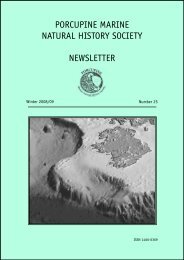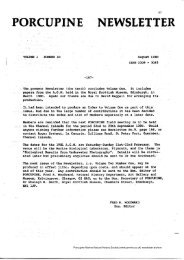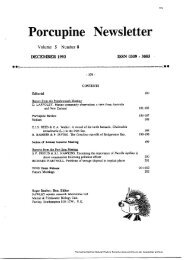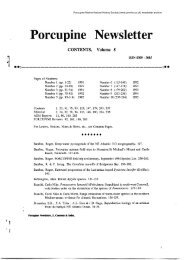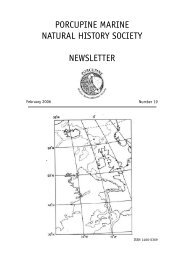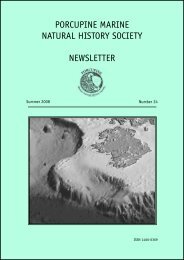33Observations and DiscussionThe majority of intertidal Mollusca inIreland are common and/or widely distributed.However, there are a few species that showdistinct patterns of distribution. For exampleBarleeia unifasciata (Montagu, 1803) is foundonly on western coasts, from Inishowenpeninsula (north Donegal) down the west coastto SW Cork. Both Simnia patula (Pennant,1777) and Eatonina fulgida (J Adams, 1797)are largely absent from the east coast ofIreland. Within this group of species, a numberhave their northern or southern limits in thenorth of Ireland. For example, Margariteshelicinus (Phipps, 1774) is only present in thenorth of Ireland in Ireland, from CarlingfordLough to south Donegal, with only a fewscattered records south from there to northGalway Bay. The nudibranch Onchidorismuricata (O F Müller, 1776) has a similardistribution.Both Tonicella marmorea (O Fabricius,1780) and Rissoella globularis (Forbes & Hanley,1853) have northern distributions within theBritish Isles (Seaward, 1990). Tonicellamarmorea has only been found recently (post-1970) living in the north of Ireland withinIreland (Rathlin Island (Antrim) to CarlingfordLough). Rissoella globularis has only beenfound recently living in the north of Irelandin Ireland (with the exception of one recordfrom Galway Bay). Both these species werefound to be relatively common in StrangfordLough in the early 1990’s (Nunn, 1994). Visitsto the same sites in the late 1990’s to date bythe author, using the same methodology,suggest that T. marmorea is less common, andR. globularis can no longer be found.Conversely, Ostrea edulis Linnaeus, 1758, anuncommon species in the early 1990’s, rarelyfound in the intertidal in Strangford Lough, isnow found at many more intertidal sites,particularly in the northern half of the Lough,and in places can be common. However, theincrease in this species is due to the seedingof selected areas of the Lough with youngoysters by local fishermen.Tectura testudinalis (Müller, 1776) isanother species with a northern distributionwithin the British Isles. In Ireland, it is onlyfound in the north east, from Mulroy Bay(Donegal) to the Cooley Peninsula (Louth). Itwas common in the main body of StrangfordLough before 1994. When searched for atseveral sites in 1997 and 1998, the speciescould not be found. However, in 1999,specimens less than 5mm in length wereobserved, and in subsequent years, thissettlement and others have established thespecies as common again throughout thelough. Caution should therefore be exercisedbefore ascribing such changes to climatechange - an understanding of the recordedhistory of a species is essential.The distribution of two species has beenstudied in detail in Strangford Lough in recentyears. These are Gibbula umbilicalis (da Costa,1778) and Osilinus lineatus (da Costa, 1778).Both these species are amongst a group ofspecies considered to be indicator species atthe limits of their range in the British Isles.In 1952-53, Southward and Crisp recorded thedistribution and abundance of a group ofrelatively common species (including G.umbilicalis and O. lineatus) around the coastof Britain and the island of Ireland (Southward& Crisp, 1954). This work is being repeated bythe MarClim project, and used to monitorpotential climate change.(a) Gibbula umbilicalisGibbula umbilicalis is a southern andwestern species in the British Isles (Seaward,1990). In Ireland, from east of Malin Head(Donegal) to Carnsore Point (Wexford), G.umbilicalis is relatively sparsely found. Priorto 1994, this species was absent from the mainbody of Strangford Lough, and only sparselypresent in the Narrows (Nunn, 1994) (Figure1). Published history suggests that this hasbeen the case since recording in the loughbegan. Dickie (1858) only recorded dead shellsfrom Castleward Bay, and Williams (1954) onlyrecorded the species from three sites in theNarrows in the 1940’s. Records from the<strong>No</strong>rthern Ireland Littoral Survey (Wilkinson etal. 1998) must be discounted as the specimenof G. umbilicalis lodged with the Ulster Museumwas incorrectly identified. The author visited118 sites in the lough between 1986 and 1992,and the species wasPMNHS <strong>Newsletter</strong> <strong>No</strong>.<strong>16</strong> <strong>No</strong>v <strong>2004</strong> 33<strong>Porcupine</strong> <strong>Marine</strong> Natural History Society (www.pmnhs.co.uk) newsletter archive
34Figure 1. Gibbula umbilicalis: all records pre-1994black dots: live records, post-1969grey dots: live records pre-1970, or shell onlyonly found alive (sparse) in the Narrows.Indeed, no dead shells were found in the mainlough (normally very persistent).In July 1999, Gibbula umbilicalis was foundby the author, during work associated withQueen’s University, commonly, at sites in thenorth-west of the main lough. The species hasnow been recorded from many sites throughoutthe lough (Figure 2). Maximum densities haveexceeded 120/m 2 . In the Narrows, densitieshave also increased - from 2/m 2 in 1989 atBallyquintin to 15/m 2 in 2003.(b) Osilinus lineatusOsilinus lineatus is a largely southern andwestern species in the British Isles (Seaward,1990). In Ireland, Osilinus lineatus has adiscontinuous distribution, being mainlyabsent from Malin Head down the east coastto Carnsore Point, apart from a stretch of coastfrom approximately St. John’s Point, Co. Downto south of Dublin. This distribution was firstpublished by Southward & Crisp (1954), and asimilar distribution (unpublished) wascompiled by the author prior to 1994.On the north coast of Ireland, east of MalinHead, Osilinus lineatus has only been recordedfrom Portballintrae in 1952 by <strong>No</strong>ra McMillan,Figure 2. Gibbula umbilicalis: all records pre-<strong>2004</strong>black dots: live records, post-1969grey dots: live records pre-1970, or shell onlyand from the Skerries, Portrush in 1979 by M.Boyle. There are no extant specimens for thelatter record. Several visits by the author toPortballintrae in 2003 and <strong>2004</strong> have failed tofind any specimens of this species.Local records for the Strangford Lougharea prior to 1994 are shown in Figure 3. Themost northerly accepted station for O. lineatuson the east of Ireland was Benderg Bay, lastseen in 1901. Casual visits there by naturalistsin recent years failed to record the species.The most northerly substantial population isat Killough, recorded in 1971 by Roy Anderson,and in 2003 by MarClim and the author. A goodpopulation was also recorded in 2000 furthersouth, from St. John’s Point by Anderson. Asingle specimen was seen in the same year bythe author at Phennick, near Ardglass - at thattime the most northerly record on the eastcoast since 1901.In August and September 2003, the authorwalked a number of sites in order to determinethe current northernmost limit of Osilinuslineatus on the east coast of Ireland. A smallpopulation was discovered in Benderg Bay(earliest settlement date 1994, ascertainedfrom growth checks on the shell), the firstrecord there for more than 100 years. Further34PMNHS <strong>Newsletter</strong> <strong>No</strong>.<strong>16</strong> <strong>No</strong>v <strong>2004</strong><strong>Porcupine</strong> <strong>Marine</strong> Natural History Society (www.pmnhs.co.uk) newsletter archive



